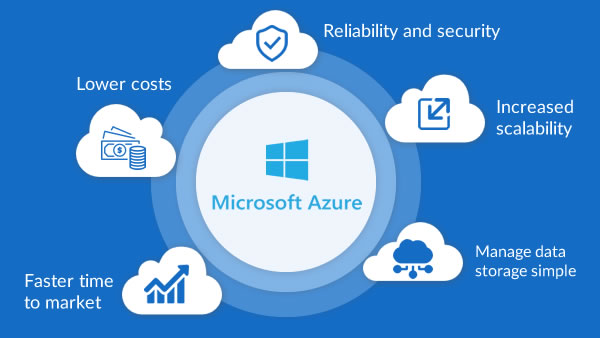Microsoft Azure Cloud computing has become a vital part of businesses today. Moving workloads and servers to the cloud allows organizations to lower costs while improving flexibility, scalability, and productivity.
Microsoft Azure is one of Microsoft’s cloud computing platforms that provides immense value. Azure offers cloud services that can benefit your organization in many ways and deliver several advantages.
Scalability means your systems can easily expand as your needs grow. Reliability ensures your applications have high availability. Security protects your critical data and infrastructure from threats. Productivity tools help your employees work from anywhere efficiently. Cost savings let you optimize expenses on your IT infrastructure.
This article explores five such key benefits of Microsoft Azure in detail through real-world examples.
1. Reliable Infrastructure as a Service Partner
As one of the largest cloud service providers, Microsoft Azure operates data centers all over the world. They have extensive regions and availability zones to host workloads. Within each region, Microsoft provisions multiple discrete data centers to protect workflows from single points of failure.
These data centers follow stringent reliability protocols. Servers are redundantly powered using multiple utility feeds and backup generators. Network links are also doubled to maximize uptime.
Cooling, security, and monitoring systems have built-in redundancies as well. With over two decades of experience, Microsoft has perfected routine maintenance activities to minimize disruption.
If any hardware falters unexpectedly, Azure can automatically restart virtual machines on alternate hosts within seconds through its hypervisor technology.
Because of its global scale and operational excellence, many organizations serve as Microsoft Partner and provide services to overcome critical challenges in cloud implementation.
2. Scalable Compute Resources on Demand
Azure offers scalable virtual machines (VMs) that come in different sizes based on memory, storage, and processor configurations. You can run everything from small workloads to memory and GPU-intensive applications on these VMs.
Azure also provides containers, Kubernetes clusters, and serverless functions for specific needs.
Regardless of what you require, resources can be provisioned within minutes from the Azure portal, command-line tools, or APIs. There are no capacity planning headaches during events.
Just raise or lower instances as demand fluctuates automatically. Behind the scenes, Azure dynamically allocates these resources from its massive pool of physical hosts spread across regions.
Its auto-scaling capabilities help adjust capacity proactively based on metrics like CPU utilization. Costs scale directly with usage, so organizations never over-provision and waste money. With flexible scaling options, any industry, from game studios to online retailers, can focus on innovation instead of infrastructure.
3. Agile Application Development Cycle
Microsoft equips developers with over 200 managed services on Azure to accelerate apps. Popular ones include Azure DevOps for version control, Azure Pipelines for CI/CD, and Azure Kubernetes Service for containers. Key development stages benefit significantly.
Coding errors are caught instantly through integration testing of code commits with Azure Pipelines. With Azure DevTest Labs, creating isolated VM images and sandbox environments is a one-click process for any branch or issue. QA teams can now deploy testing apps side-by-side with live production apps safely on the cloud.
When done, developers can execute blue/green deployments to roll out changes directly onto staging slots and swap with production traffic seamlessly. For rollbacks, Microsoft Azure App Configuration stores settings allowing instant rollbacks to previous versions. Overall, this streamlines app lifecycles on Azure from planning through implementation, test, and release cycles.
4. Cost Optimization and Savings
On Azure, you only pay for actual consumption of computing resources on an hourly basis. This lets businesses avoid overprovisioning costs. If workloads spike temporarily, Microsoft Azure scales out VMs or functions instantly.
Once finished, those resources are discarded, and billing stops. Storage accounts offer transactional charges for data access instead of capacity fees. Even database transactions are charged only when queries are run. Idle servers or empty databases do not incur recurring license renewal or maintenance expenses.
Detailed cost reports help uncover optimization areas, too, through recommendations on reserved VM instances or hybrid-use rights. For disaster recovery, Microsoft Azure Site Recovery replicates on-prem VMs to the cloud without bandwidth fees.
Coupled with its pay-as-you-go flexibility, businesses of all sizes use Microsoft Azure to stretch budgets and experiment fearlessly with new capabilities.
5. Disaster Recovery and Business Continuity
Microsoft Azure ensures operations remain uninterrupted from outages through its globally distributed regions and availability zones. Should a natural disaster turn off an entire Microsoft Azure data center, workloads are automatically migrated to other healthy zones within the same region, typically in under a minute.
For greater tolerance, apps can be geo-replicated across two regions over 100 miles apart for redundancy.
Fault domains isolate infrastructure components, too: even if a power grid or network switch fails, half the servers in a zone continue functioning. Regular data backups and restore tests enhance reliability further. Snapshots capture VM configurations while file shares retain application data and file server contents.
In case of corruption, recovery is polished off within minutes from the last backup point. With automated recovery plans tested regularly, Azure safeguards organizations against unexpected disruptions without much effort or maintenance overhead from their end.
Conclusion
Microsoft Azure cloud services deliver reliable infrastructure, flexible scalability, agile development, cost optimization, and disaster recovery benefits that improve your business productivity, resiliency, and faster innovation.
The cloud removes technological constraints so you can focus on growth.
Keywords: services microsoft azure, does azure work, azure how











